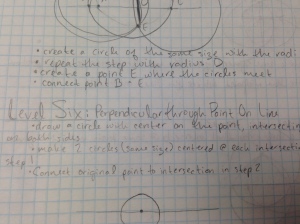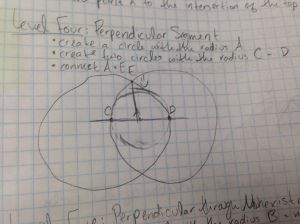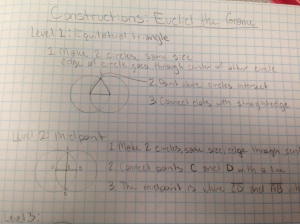Last year I wrote a post about how I wanted to improve my teaching of geometric constructions this year.
This year, I re-read it and used it to help plan this unit better. I never provided the students with steps to make constructions! It was tempting, but I resisted the urge, and they did great!
Here is the sequence that I followed and plan to use next year:
Day 1 – Play with http://sciencevsmagic.net/geo/ see how many of the challenges you can complete. I then had students submit a screen shot of their completed challenges through Google Classroom.
Day 2 – I assigned the construction design project described in my previous constructions post (and linked below). [credit for the designs: Mr. Baroody]
I gave the students compasses and paper to experiment and relate this to the computer task yesterday. They had to complete this at home. There was no discussion of “constructions” just making designs precise and accurate. Here are some students final designs:
Days 3/4 – Working in pairs, students alternated roles for each level of Euclid, the game with one student operating the laptop and the other writing down the steps they used to complete each level. We only completed up to level 6. These steps became their notes for constructions.
(Note: there is a geogebra constructions tutorial here.)
Day 5/6 – Construction station rotation – I randomly assigned groups and students rotated with their groups through different stations completing paper and compass constructions, using Popsicle sticks as their straightedges, so they couldn’t rely on measurements. They used their notes that they developed from playing Euclid the game. Sometimes they noticed that their notes were not sufficient, but since they had new partners, they would compare and add notes & diagrams as needed to improve their descriptions.
Day 6 – Constructions extensions. I asked them to apply their knowledge of constructions to new tasks, such as finding 1/8th of a segment, constructing a equilateral triangle and constructing a rhombus.
Students were so much more proficient at using a compass than at the end of this unit last year!
I think I need to develop more construction extension challenges to build on their basic skills next year. I may make a list of challenges and assign point values to them and then assign a total point value that they can get a variety of ways.
Please comment with any ideas to improve this sequence of tasks as an introduction to constructions that builds student confidence while supporting their creativity and problem solving.
















